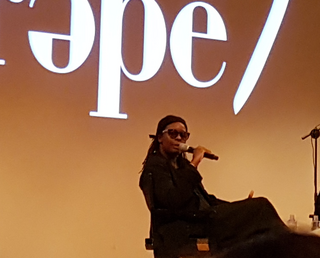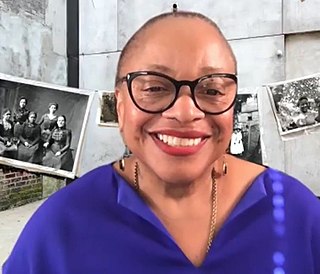Yo Mama's Last Supper is a work of art, made in 1996 by Jamaican-American artist Renée Cox. It is a large photographic montage of five panels, each 31 inches square, depicting photographs of 11 black men, a white Judas and a naked black woman posed in imitation of Leonardo da Vinci's 1490s painting The Last Supper. Cox is pictured naked and standing, with her arms reaching upwards, as Jesus.

Lorraine O'Grady is an American artist, writer, translator, and critic. Working in conceptual art and performance art that integrates photo and video installation, she explores the cultural construction of identity – particularly that of Black female subjectivity – as shaped by the experience of diaspora and hybridity. O'Grady studied at Wellesley College and the University of Iowa Writers' Workshop before becoming an artist at age forty-five. Regarding the purpose of art, O'Grady said in 2016: "I think art’s first goal is to remind us that we are human, whatever that is. I suppose the politics in my art could be to remind us that we are all human."
Dame Sonia Dawn Boyce is a British Afro-Caribbean artist and educator, living and working in London. She is a Professor of Black Art and Design at University of the Arts London. Boyce's research interests explore art as a social practice and the critical and contextual debates that arise from this area of study. Boyce has been closely collaborating with other artists since 1990 with a focus on collaborative work, frequently involving improvisation and unplanned performative actions on the part of her collaborators. Boyce's work involves a variety of media, such as drawing, print, photography, video, and sound. Her art explores "the relationship between sound and memory, the dynamics of space, and incorporating the spectator". To date, Boyce has taught Fine Art studio practice for more than 30 years in several art colleges across the UK.
Wangechi Mutu is a Kenyan American visual artist, known primarily for her painting, sculpture, film, and performance work. Born in Kenya, Mutu now splits her time between her studio there in Nairobi and her studio in Brooklyn, New York, where she has lived and worked for over 20 years. Mutu's work has directed the female body as subject through collage painting, immersive installation, and live and video performance while exploring questions of self-image, gender constructs, cultural trauma, and environmental destruction and notions of beauty and power.
Alison Saar is a Los Angeles, California based sculptor, mixed-media, and installation artist. Her artwork focuses on the African diaspora and black female identity and is influenced by African, Caribbean, and Latin American folk art and spirituality. Saar is well known for "transforming found objects to reflect themes of cultural and social identity, history, and religion." Saar credits her parents for her exposure to these metaphysical and spiritual practices. Her mother, Betye Saar, is a collagist and assemblage artist and her father, Richard Saar, is a painter and art conservator. Saar followed in her parents footsteps along with her sisters, Lesley Saar, who is also an artist, despite wanting to get out of her parents shadow. She finds more gratification in making art than writing about it, as she found out after finishing a dual major in fine arts and art history.

Mickalene Thomas is a contemporary African-American visual artist best known as a painter of complex works using rhinestones, acrylic, and enamel. Thomas's collage work is inspired from popular art histories and movements, including Impressionism, Cubism, Dada, the Harlem Renaissance, and selected works by the Afro-British painter Chris Ofili. Her work draws from Western art history, pop art, and visual culture to examine ideas around femininity, beauty, race, sexuality, and gender.
Kimathi Donkor is a London-based contemporary British artist whose paintings are known for their exploration of global, black histories. His work is exhibited at and collected by international museums, galleries and biennials including London's National Portrait Gallery, the British Museum, the Diaspora Pavilion at the 57th Venice Biennial, the 29th São Paulo Art Biennial and the 15th Sharjah Biennial. He is of Ghanaian, Anglo-Jewish and Jamaican family heritage, and his figurative paintings depict "African diasporic bodies and souls as sites of heroism and martydom, empowerment and fragility...myth and matter".
Renée Stout is an American sculptor and contemporary artist known for assemblage artworks dealing with her personal history and African-American heritage. Born in Kansas, raised in Pittsburgh, living in Washington, D.C., and connected through her art to New Orleans, her art reflects this interest in African diasporic culture throughout the United States. Stout was the first American artist to exhibit in the Smithsonian's National Museum of African Art.

Deborah Willis is a contemporary African-American artist, photographer, curator of photography, photographic historian, author, and educator. Among her awards and honors, she is a 2000 MacArthur Fellow. She is currently Professor and Chair of the Department of Photography and Imaging at Tisch School of the Arts of New York University.
Caribbean art refers to the visual as well as plastic arts originating from the islands of the Caribbean. Art in the Caribbean reflects thousands of years of habitation by Arawak, Kalinago, and other people of the Caribbean followed by waves of immigration, which included artists of European origins and subsequently by artists with heritage from countries all around the world. The nature of Caribbean art reflects these diverse origins, as artists have taken their traditions and adapted these influences to reflect the reality of their lives in the Caribbean.

Howardena Pindell is an American artist, curator and educator. She is known as a painter and mixed media artist, her work explores texture, color, structures, and the process of making art; it is often political, addressing the intersecting issues of racism, feminism, violence, slavery, and exploitation. She is known for the wide variety of techniques and materials used in her artwork; she has created abstract paintings, collages, "video drawings," and "process art."

Dindga McCannon is an African-American artist, fiber artist, muralist, teacher author and illustrator. She co-founded the collective Where We At, Black Women Artists in 1971.

Joyce J. Scott is an African-American artist, sculptor, quilter, performance artist, installation artist, print-maker, lecturer and educator. Named a MacArthur Fellow in 2016, and a Smithsonian Visionary Artist in 2019, Scott is best known for her figurative sculptures and jewelry using free form, off-loom beadweaving techniques, similar to a peyote stitch. Each piece is often constructed using thousands of glass seed beads or pony beads, and sometimes other found objects or materials such as glass, quilting and leather. In 2018, she was hailed for working in new medium — a mixture of soil, clay, straw, and cement — for a sculpture meant to disintegrate and return to the earth. Scott is influenced by a variety of diverse cultures, including Native American and African traditions, Mexican, Czech, and Russian beadwork, illustration and comic books, and pop culture.
Deborah Cullen is an American art curator and museum director, with a specialization in Latin American and Caribbean art.
Sandra Brewster is a Canadian visual artist based in Toronto. Her work is multidisciplinary in nature, and deals with notions of identity, representation and memory; centering Black presence in Canada.

Vladimir Cybil Charlier is an American visual artist who lives and works in New York City. Her works reflect the complex dynamics linking two important geographic markers: The Caribbean and the United States. Her parents' migration into the United States allowed her to receive an education in fine arts and become a mix media artist. Her work includes paints, drawings, sculptures and others. Today she has a variety of work collections that have been displayed in numerous exhibitions within the United States and abroad.

Margaret Rose Vendryes was a visual artist, curator, and art historian based in New York.

Brenda Patricia Agard was a Black-British photographer, artist, poet and storyteller who was most active in the 1980s, when she participated in some of the first art exhibitions organized by Black-British artists in the United Kingdom. Agard's work focused on creating "affirming images centred on the resilience of the Black woman," according to art historian Eddie Chambers.
Andrea Fatona is a Canadian independent curator and scholar. She is an associate professor at OCAD University, where her areas of expertise includes black, contemporary art and curatorial studies.
Julie Crooks is a Canadian curator, researcher and instructor. She has been the head of the department of Arts of Global Africa and the Diaspora at the Art Gallery of Ontario since its founding in 2020.









